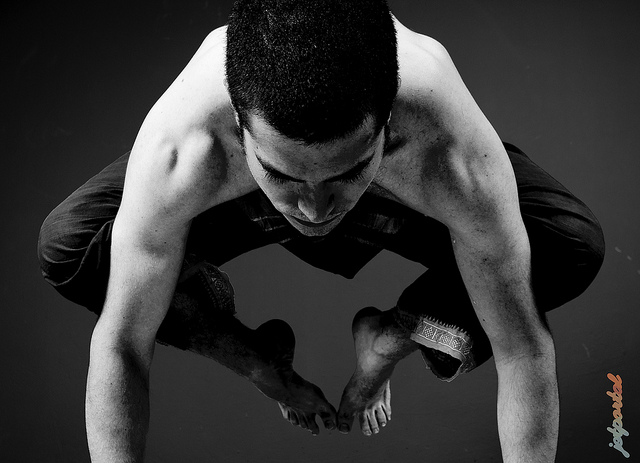I’ve always said, if I were to hold a yoga workshop where we all bring our nemesis poses to class—and work on them until we make peace with them—I could almost guarantee that it would be almost a complete afternoon of arm balances.
If you’re someone who is not on speaking terms with a lot of arm balances, don’t worry—you’re not alone.
Firstly, as with all asana, when we understand the underlying principles of the pose, the pose becomes not only approachable, but fun—yes, even arm balances! Remember that in yoga, we are practicing principles in the form of the poses—we’re not trying to perform poses. Let’s lose our attachment to trying to mold the body into a particular form, and become satisfied with understanding and accomplishing the fundamental principles behind the pose.
We can perfectly demonstrate the principle, regardless if we ever arrive in what looks like the perfect Crow Pose (Bakasana), Stick Pose (Koundinasana) or Crazy 8s (Astavakrasana). There is a version of every arm balance for everybody. Even though we may not be attached to the form of the pose, when we are still able to master a principle, and it’s fun to see how the body responds by accomplishing poses that perhaps we initially didn’t think were possible.
Arm balances build strength and confidence, both in body and character. They cultivate our ability to hold ourselves in a way that’s different than normal. To practice arm balances, we use our deep inner-strength—our core being. Arm balances work not only our physical strength, but also our strength to do something that scares or challenges us.
The following are some of the principles we use to practice arm balances:
Grounding.
Establishing our ground is essential for every pose. For arm balances, we ground using our arms or hands. Therefore, we generally ground the hands shoulder-distance apart from each other. Connect to the floor with as much surface of the palm as possible by spreading the fingers wide, then gripping with the fingertips to establish the muscular support for negotiating balance and decompressing the wrists.
Wrist pain is often a deal-breaker for many practitioners. Strength in the forearms and gripping with the hands is one way to stay out of the wrists in arm balances. In class, we practice other ways to avoid injuring the wrists.
Legs, Hip-flexors and Abdominals. (Uddiyana Bandha)
To perform arm balances, not only must we ground in a way that doesn’t use our legs, but we must also hold our legs off the floor. The muscles responsible for keeping the legs hugged into the body—and/or our legs holding our arms—are our hip-flexors (the muscles in the groins), the adductors (muscles that pull the legs together) and the abdominal muscles.
Uddiyana Bandha (oo-dee-yana bahn-dah) is one of the three special muscular locks we use in yoga. It is the essence of our core strength and helps direct the flow of energy in our body. There are a few ways to perform Uddiyana Bandha. In arm balances we will practice this lock by drawing the lower abdominal muscles up and in, while maintaining our breath. In class, we cultivate awareness of the legs, hip-flexors and Uddiyana Bandha and learn how to apply them to arm balances.
Breath.
Breath is perhaps the most important principle in our asana practice, especially when we are practicing challenging poses such as arm balances. Sometimes we instinctively hold our breath and grunt our way through the pose. Holding our breath starves our muscles of oxygen, and it’s no wonder we find ourselves unable to do the pose.
If we establish the pattern of deep breathing known as ujjayi (oo-jie-ee), in and out through the nostrils, using the muscles in the back of the throat to slightly constrict and elongate the breath, creating a whisper—we calm the nervous system at the same time that we provide copious fuel for our muscle fibers. This breath is key to all poses, including arm balances.
Sense of humor.
As with all of these poses, we don’t become any more enlightened by the ability to perform arm balances. Instead, enlightenment is what we learn is along the path as we practice these poses and practice life. The asana is simply practical application to the lesson—again practicing principles in the form of asana. So a healthy sense of humor is essential, because it’s not about the pose–it’s about my attitude in the pose.
Do I strain, grunt and groan my way through it? Do I perform the pose easily and look around self-righteously at all the other losers who are grunting and groaning their way through the pose? Do I not even try, for fear that I’ll fail?
It’s all just a practice—just a game. Have fun with it. Do what is possible, understanding that you are somewhere along a winding path of progression. If you don’t master the physical pose today, you may still master the anatomical or mental or spiritual principles behind the pose. And who knows, you might surprise yourself and someday master the physical pose, too.
At the end of the day, lets ask ourselves what arm balances and other challenging poses might teach us about ourselves.
.
Author: Scott Moore
Editor: Yoli Ramazzina
Photo: Flickr/jeffrey montes












Read 1 comment and reply